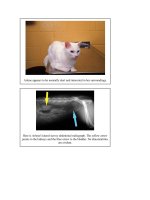chan doan hinh anh
Bạn đang xem bản rút gọn của tài liệu. Xem và tải ngay bản đầy đủ của tài liệu tại đây (109.96 KB, 4 trang )
Arlene appears to be normally alert and interested in her surroundings.
Here is Arlene's lateral survey abdominal radiograph. The yellow arrow
points to the kidneys and the blue arrow to the bladder. No abnormalities
are evident.
This is a different case. The blue arrow points to the bladder and the red
arrow points to a radiodense calculus. We cheated on this image in that
the calculus was less dense on the original film so we image intensified it
to make it easier to see.
This is the ultrasound image of Arlene's bladder. The light blue arrow
points to the lumen of the bladder. The dark blue arrow points to the
bladder wall which is uniformly thicker than normal. It normally appears
as just a fine line.
This is an ultrasound image of the bladder of a different case. The light
blue arrow points to the lumen of the bladder. There are calculi in this
bladder as noted by the white arrow.
This is a double contrast cystogram of Arlene's bladder. The light blue
arrow points to the lumen of the bladder with a puddle of radiopaque
contrast material. The dark blue arrow points to the bladder wall which is
uniformly thicker than normal, confirming the ultrasound findings.
Work Sheet #7
A 3-year-old, neutered, female, domestic shorthaired cat, Arlene, is presented with a
history of dysuria and hematuria for 2 days. The same problem occurred 1 year ago and
the signs resolved in a few days (Arlene received ampicillin, administered orally for 5
days). The problem recurred 6 months ago. A new veterinarian was consulted and
prescribed keflex orally for 1 week. The cat again returned to normal within 5 days. The
present episode is the third and the cat's owner is trying another veterinarian - you.
On physical examination the cat seems normal. The bladder is small and seems to
become firmer as you palpate it. Immediately after you finish palpating, the cat goes to
the corner of the table, squats and urinates bright red urine. Urinalysis on this sample
shows: pH 6, Sp. Gravity 1.045, protein-trace, glucose - negative, ketones - negative,
occult blood-large, RBC - innumerable, WBC - 5-10/hpf.
1. How would you define the cat's problem? What are your rule outs in the order of what
you think is most likely?
2. What is your diagnostic plan?
3. See Arlene's radiographs. Given these findings, what is the most likely rule out and
what is your therapeutic plan?
4. What is the likelihood of recurrence of signs in this cat? How would you educate the
owner and try to prevent recurrence









